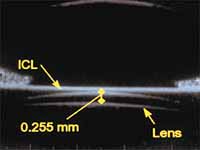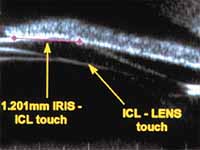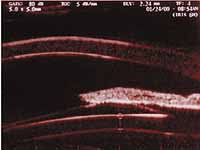Proper ICL vaulting important
Central vaulting does not necessarily mean complete separation between the crystalline lens and the ICL.
The implantable contact lens (ICL), a posterior chamber phakic IOL made by STAAR Surgical AG (Nidau, Switzerland), can be folded and injected through a 3-mm self-sealing clear-corneal incision under topical anesthesia.
Perfectly fitting the ICL in the posterior chamber depends on lens design and lens sizing. These factors determine the position of the ICL in the posterior chamber, especially its vaulting — the phakic lens should neither touch the natural lens nor obstruct the normal circulation of the aqueous humor.
The concern about whether the ICL touches the crystalline lens has received much attention, because intimate contact between the artificial and the natural lenses raises the possibility of cataractogenesis.
Ultrasound biomicroscopy
Ultrasound biomicroscopy (UBM) is helpful to identify the position of the posterior phakic IOL. Preoperatively, UBM can also show the existence of iridociliary cysts and other disorders that cannot be seen through slit lamp examination and would interfere with the ICL’s normal position.
In a previous UBM study featuring version-2 ICL for the correction of high myopia, we observed the ICL clearly vaulted over the crystalline lens centrally; however, it touched the crystalline lens in mid-periphery in most cases, under the thickest part of the ICL, which is located at the optic-haptic junction.
So central vaulting does not necessarily mean separation between the crystalline lens and the ICL.
Contact between the ICL and the crystalline lens in midperiphery does not cause prompt opacification; however, it may block the normal circulation of the aqueous humor. A pool of aqueous stagnation may be responsible for the anterior subcapsular opacification seen in a few cases after uneventful implantation in the late postop period.
It is important to state that no ICL-induced cataracts have been reported with the hyperopic model, most likely because of its design, which avoids blockage of normal aqueous circulation.
Ideally, the ICL should bend forward, leaving a space between the phakic and crystalline lenses. However, ICL vaulting must not cause excessive contact with the posterior surface of the iris, which could lead to pigment dispersion, increasing the risk of developing glaucoma, especially in highly myopic eyes.
So proper ICL sizing is of paramount importance as it dictates vaulting and positioning of the ICL in the posterior chamber. ICL sizing calculation is crucial. Unfortunately, it is still based on the white-to-white measurement, which is an indirect and not very accurate assessment of the ciliary sulcus diameter and can be misleading in some cases.
The golden rule
We need a more precise and direct way to measure the ciliary sulcus diameter to improve ICL sizing determination, instead of using the recommended “golden rule,” which is to add 0.5 mm to the horizontal white-to-white distance for the myopic model and to subtract the same amount for the hyperopic one.
Small sizing miscalculations can bring about great errors in ICL positioning, and this “golden rule” can be criticized for lack of accuracy.
In adult life there is a steady axial growth of the crystalline lens of about 25 µm per year, which may be responsible for vaulting reduction with time, with all the negative consequences. That is why higher vaulting values are welcome, such as the recently recommended range of 300 µm to 600 µm.
Should cataract occur, the solution is simple because the ICL is easily explanted through the original clear-corneal incision. Routine phacoemulsification and IOL implantation are then done, which, in reality, represent an alternative form of treatment, especially for high myopia in adults.
 
Version-2 ICL. Left: central vaulting of 0.255 mm. Right: ICL touches the crystalline lens in mid-periphery.    
Upper left: ICL central vaulting and mid-periphery contact with the crystalline lens; upper right: stagnation of aqueous humor due to the blockage of its normal circulation; lower left: anterior subcapsular cataract formation; lower right: anterior subcapsular cataract in a 31-year-old patient 1 year after uneventful Version-2 ICL implantation.  
Version-4 ICL: complete separation between ICL and crystalline lens. |
For Your Information:
- Fernando Trindade, MD, PhD, can be reached at the Federal University of Minas Gerais, Rua Manaus, 595 Belo Horizonte, MG-30150.350 — Brazil; +(55) 31-241-5544; fax: +(55) 31-241-4021; e-mail: fct@gold.com.br. Dr. Trindade has no financial interest in any of the products mentioned in this article.
